Introduction
Cases for Pocket PC and other devices now come in a variety of materials. You have leather cases running from the more common cowhide leather to the exotic leathers like alligator or ostrich. Metal cases are available in aluminum or the more exotic magnesium. Silicones and plastic cases are also options. We can’t say that we don’t have a plethora of choices.
I have used both leather and metal cases as far back as my iPAQ h3850. But the BoxWave Active Case is the first plastic case that I have had a chance to use and review. I was really curious to see how it would fare against other types of cases and I used it for a number of weeks before I even sat down to write the review.
What you get
The case showed up in a clear blister pack. Aside from the case, you also get a removable belt clip and two small screws (one is a spare) used to attach the case to the belt clip. Figure 1 shows the contents (except that you don’t get the iPAQ).
A look at the case
The BoxWave Active Case is a made of crystal-clear plastic that is contoured specifically for the model for which it is made (in this case an iPAQ hx2000). It is a flip-type case where the lid flips upwards, in this case using a double hinge system that allows the lid to lie flat when the case is open and on a flat surface (See Figure 3). The sides are ridged to improve grip and the edges are rounded like those of the iPAQ. Pop open the case and, at the sides, you will see two clasps that curl inward to hold the iPAQ in place.
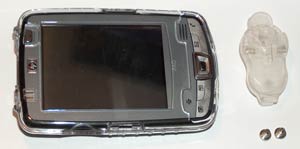
Figure 1: The Active Case, clip and screws
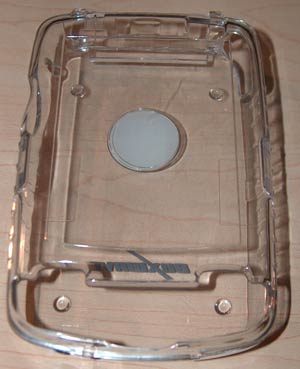
Figure 2: Empty case
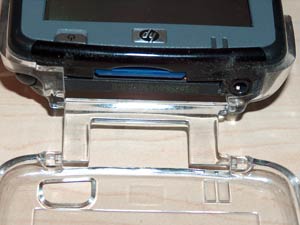
Figure 3: Hinge close up
The case features cutouts for all the buttons and ports. Combined with the fact that the clear is made of clear plastic and that you can see the screen even when the case is closed, it is possible to use the device without opening the case. On the front, a large cutout exposes the hardware buttons, d-pad, speaker and microphone. The power button, stylus, headphone jack, Notes button, sync port and reset button are similarly available. The plastic over the two lights for Bluetooth and power is thinned out, presumably so you can see them better.
Overall, the case is well made. The lid fits neatly onto the case body with the edges lining up perfectly and without any misalignment. The hinge works smoothly and is completely quiet.
Unlike some other cases I have seen, the case does not offer storage slots for your memory cards. And if you use any accessories that change the form factor of your iPAQ (eg, an extended battery), the case will either not fit well or will not fit at all. Like metal cases, there is no give in the material to adapt to a modified form factor.
Using the Active Case
To put the iPAQ into the case, you simply open the case and slide it in from the side so that it catches under the clasp. Then you gently press down on the other side so that it slides under the second side clasp. Close the lid and you’re set. The fit is quite snug but not so that you cannot take the iPAQ out later.
Pulling the iPAQ out proved slightly more difficult. You open the case and pull it out. The difficulty lies in getting good leverage because the case covers so much of the sides of the iPAQ. In the end, I used a finger nail in the depression around the Notes button. The first few times I did this, I was also worried that one of the clasps might break. But the clasps have proven quite resilient to my almost daily ritual of taking the iPAQ out or putting into the case.
One thing I immediately noticed with this case is how little bulk it adds to the iPAQ. The plastic is no thicker than a few millimeters (about the thickness of a quarter). If you’ve used leather cases in the past and have complained about the bulk that they add, this case will pleasantly surprise you.
The combination of clear plastic and easy access to the hardware buttons is the perfect combination for someone who wants to have access to basic functionality while leaving the iPAQ in a closed case. One hardware button click and the information you are looking for is at your fingertips. Obviously, functions that require use of the stylus will still force you to open the lid. The cutouts are generous enough that you will not find any interference when using any of them. At the same time, I never had issues with buttons being accidentally pushed.
The case has one failing when it comes to the cutouts. You will not be able to insert or pull out a CF card. If the case is not completely open, the hinge gets in the way and prevents easy access to the CF card. Lying the lid completely flat (remember that double hinge?), you cannot get the CF card out because a tiny bit of the case (about 2 mm) blocks the card in. Simply put, you will need to pull the iPAQ out of the case to put in or remove a CF card.
After using the case for about a month, I found that the lid will sometimes pop open on its own when the case is on my belt. A closer look at the closing mechanism reveals that it is simply two small plastic knobs that click into two corresponding cavities. My first suspicion was that the knobs might have worn down enough to weaken the system. But it does not appear to be the case. My next suspicion was that it could be that there was too much stuff on my belt (iPAQ, iPod nano, sometimes 2 cell phones). Out of curiousity, I tried just having my iPAQ on my belt for a few days. It seemed to resolve the problem except for one or two isolated instances. Unfortunately, I would only notice when the case was open so I’m still not sure what circumstances cause this. It might be that I hook it on something or that it pops open when I sit down somewhere. It remains a small annoyance.
One question that I’m still wondering about is how well the latching system and the clasps will work in a few months. If either wear out or break off, the case would then become unusable. Although a possibility, there is no evidence after more than 6 weeks of daily use that this will happen any time soon.
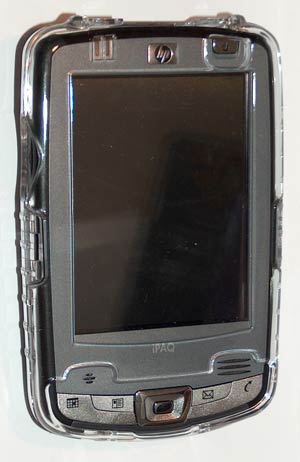
Figure 4: iPAQ in the Active Case
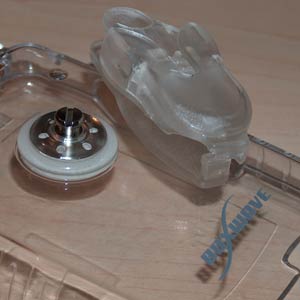
Figure 5: Closeup of the belt clip
One thing that has happened though is that the case is starting to show some wear and tear. The front of the case is showing some faint scratches and sports one nice gouge. I’m not sure where the case picked that last one but I’m glad that it’s the case and not my screen!
The case also comes with a removable belt clip and a screw (you also get a spare). When you want to use the beltclip, you attach the screw to a round fairly flat protrusion (about 5mm high and smaller than a quarter in diameter) at the back of the case. The case is then ready to clip into the beltclip. The system is easy to use and works very well. The clip works smoothly and I like the convincing click you hear when the case clips in. It is big enough to support belts that are up to 3.5 cm (1.5 inches) in width.
The one issue I had was with the screw. I have to retighten it on a regular basis. My fear is that one day I will forget to do so and will end up watching my iPAQ and Active Case fall to the ground.
Other features
Like most cases out there, the dock will not accept the iPAQ while it’s in the case. You can either take it out or just use the sync cable (there is a cutout for the port on the case).
One thing that I wondered about when I first got the case was how much fingerprints would show on the case. Although they might show under certain light conditions, the case proved to be quite smudge-proof.
What I liked
- Access to iPAQ functions that use hardware buttons without having to open the case
- Little bulk to the device added by the case
What I did not like
- Lid opens when on my belt
- Beltclip screw loosens up over time
- No storage slots for memory cards
Summary
Like other materials, plastic has its own benefits and compromises. The Boxwave Active Case has two real strong advantages over other cases in my opinion. The first is that the combination of clear lid and button cutouts allow you to use the iPAQ without opening the case. The second is the minimum bulkiness that the case adds to the device. And most of the negatives that I had with this case were not specific to the Active Case and plastic cases and could be limitations with leather and metal cases just as easily.
In the end, I was pleasantly surprised at how well plastic cases and the BoxWave Active Case in particular can work.
Rating
![]()
Where can I get it?
You can purchase the Active Case from BoxWave for $23.95 USD (for an iPAQ model). BoxWave also offers the active case for a variety of different devices including iPods, Dell Axims and models from i-mate, PalmOne among many others.
